#anyway. obsessed with them . ive never seen some of these bps so its fun to revisit
Explore tagged Tumblr posts
Text
"mitch had this one today" about his own stick... known gearhead am34 just letting mitch run around with his sticks like that........ okay
#sorry but thats crazy some of these guys are so superstitious they wont even let other guys handle their stuff#what do u MEAN mitch had this one today#anyway. obsessed with them . ive never seen some of these bps so its fun to revisit#2021
36 notes
·
View notes
Text
I recently re-watched Season 1 of Fargo FX and, as is the case with every great show or movie, there were things I noticed that I had missed in earlier viewings. A few of these had to do with the portrayal of hospitals in film, which is another small obsession of mine, so I thought that I would take the time to combine these two interests and talk about the way that Fargo FX depicts hospitals. I will be mentioning the inaccuracies in this portrayal and the way that the liberties that are taken advance the plot and enhance the mood of certain scenes. By pointing out these inaccuracies, I am not trying to criticize the show or its writers, I’m just using my specific experiences to talk at length about something I love.
(Also, this post will contain big ol’ spoilers for Season 1 of Fargo FX, so go watch it if you haven’t yet and then come back.)
There are a few scenes that I wanted to discuss here, and I will bring them up chronologically. In episode 5, Lester is rushed to the hospital in an ambulance with what appears to be sepsis resulting from a shotgun pellet lodged in his hand. In the following episode, he sneaks out of the hospital to frame his brother for his wife’s murder. He does this by switching beds with his roommate, whose face is bandaged. As far as accuracy goes, it pretty much goes without saying that this concept is pretty farfetched, but I’ll run down the issues here anyway.
It’s never really clear to me what injuries require intensive care in this show (more on that later), but I will say that Lester recovers from sepsis in what must be record time. When I had more or less the same thing, my body essentially held down its own power button and restarted everything. I was in the ICU for multiple days, though I’m not sure how many because I wasn’t lucid the entire time, and I was pumped full of fluids and antibiotics, as well as hooked up to multiple tubes and wires.
Lester, however, is in excellent condition pretty much as soon as the source of his infection is removed, despite having been delirious, vomiting, sweating, shivering, and all that other fun stuff only the night before. His room seems to be on the general ward and the only thing hooked up to him is an IV, which appears to be dispensing saline and nothing else.
He is also under the care of what may be the least competent nurse I’ve ever seen in any show. Nurse Farber comes in to transport Lester’s roommate to radiology, but if she had checked his bracelet, she would have realized she was transporting the wrong patient. She also moves the entire hospital bed, rather than moving the patient to a gurney or a wheelchair, as has been my experience in the past (those beds are portable, but they’re very heavy and unwieldy).
However, these aren’t “mistakes”. They are deliberate choices that serve to move the plot along. We can’t put the story on hold so that Lester has a couple of weeks to recover and gain his strength back, so that process needs to be hurried along for the sake of the plot. If the nurse had checked his bracelet, his plan would have been foiled and, again, the plot would not be able to progress. If she had moved him to a wheelchair or gurney, he wouldn’t have been able to smuggle a change of clothes with him. So, these choices don’t arise from the writers’ ignorance of hospital procedure, they just need to bend some aspects of reality to advance the plot.
I would also like to point out some things this scene gets right about the hospital (based on my experience).
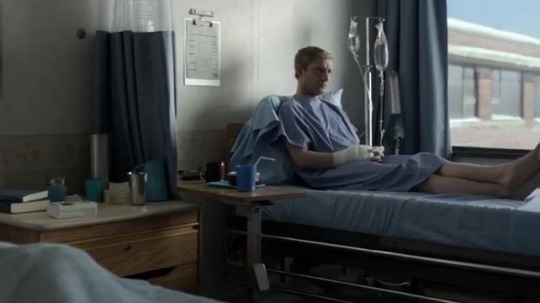
This room layout is pretty accurate. I like the little details like the plastic cup + bendy straw that everyone always has on their bedside table (even if you can lift a cup to your mouth, a bendy straw is required. It’s like an unwritten rule). I like the detail that the windows don’t open and I really appreciate that they didn’t have Lester pull out his IV like every renegade tv character seems to do. Instead, he simply disconnects the port from the tube so that he can move around, which I’m sure is more difficult than he makes it look but it’s leaps and bounds better than the old rip-em-out technique that I seem to see all the time.
I also like that the nurse uses the pain scale, which is pretty standard but I get a kick out of it. And, believe it or not, I have actually been deposited in the hall and left alone by nurses while waiting for imaging, which is how Lester manages to escape in the first place. Personally, I’ve never made it out the front door, but I haven’t tried that hard.
Now that we’ve talked about how the writers take liberties to advance the plot, let’s look at how similar inaccuracies can be used enhance the mood of a scene. If you want to see me get emotional (you sadist), get me talking about episode 7. In this episode, Molly, having been hospitalized after an emergency splenectomy, makes a trip from her room on the general ward to question Mr. Wrench, who is in custody in the ICU after having been shot twice by her (it’s not clear where he was shot, but he indicates his upper right chest, so somewhere in that area). He uses a white board to ask about his partner (Mr. Numbers) and Molly confirms that he is dead. She makes an attempt to connect with him and asks for his help in finding Lorne Malvo, but he shuts her out by refusing to look at her and she leaves. Later, in episode 8, Malvo shows up to taunt Wrench about having killed his partner, as well as to commend him for coming closer to killing him than anyone else had in the past. He gives Wrench the handcuff key and leaves.
Like I said earlier, it’s not clear what requires intensive care in this show, since Mr. Wrench doesn’t appear to be any worse off physically than Molly is (or than Lester was earlier). He does have more stuff attached to him, which is…good(?), but let’s talk about this ICU room:
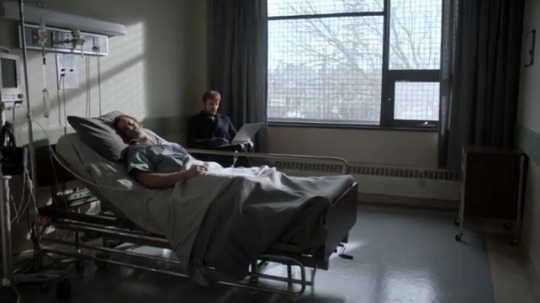
This looks nothing like any ICU room I’ve ever stayed in. For one thing, in my experience the bed has always been facing the door, not inward to the rest of the room. I assume this is to make it easier to provide emergency care, which is the function of just about everything in the ICU. For this same reason, there’s very little privacy; the doors are usually clear glass and people come in and out all the time (nobody checks on patients in this show).
As I mentioned above, he has more “gear” (no, that’s not the correct term, but just be glad I didn’t call it “swag”) than either Molly or Lester, but far less than I would expect to see. There are maybe two bags on that IV pole, so probably saline and morphine (no blood/plasma/antibiotics/other medications). He’s got a heart monitor and a pulse oximeter, but no oxygen or bp monitor. Whether I like it or not, I’m always given oxygen in the ICU (which I tend to remove as soon as possible, apologies to my nurses) and if he was shot in the chest, he might actually need it. I’m also not convinced that heart monitor is working, since it doesn’t fluctuate at all when Malvo shows up in episode 8. ALSO: that bed rail should be up; I don’t care if he is handcuffed in place, that looks like a fall risk to me. Who is running this place?
(I’m also kinda jealous, because I’ve never been in an ICU room with this much natural light.)
As I mentioned before, there is specific intent behind these omissions and changes. For one thing, if there were several different machines and wires and lines and the like, the shot would be really busy and it would be distracting, both visually and auditorily, as hospital equipment tends to beep and beep and beep and beep.
Additionally, the shots are very clean, which effectively communicates a sterile environment to the audience; the natural light from the window compliments the Season 1 aesthetic really well and it also contributes somewhat to the coldness of the scenes in this room.
Speaking of which, this is as good a time as ever to bring up something I only consciously noticed very recently. Let’s go back to episode 7 and take a look at the difference between his room and Molly’s.
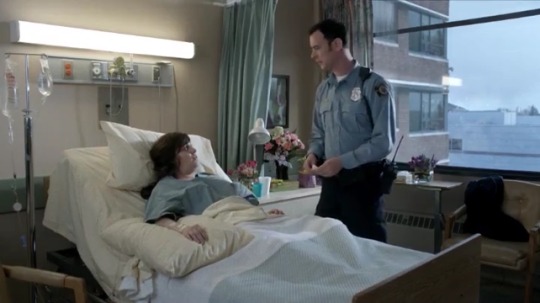
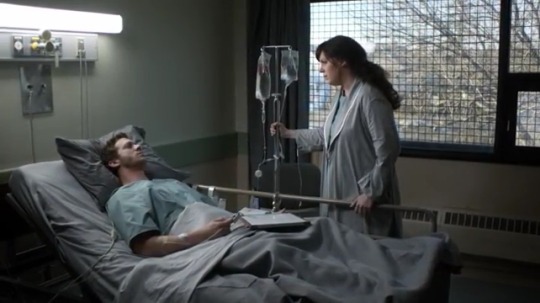
It’s very subtle, but the light above her bed is a warmer tone; her bedding is also comprised of warmer, lighter tones. Additionally, there’s some framed artwork on the wall, and most importantly she is surrounded by people (and flowers) in every shot.
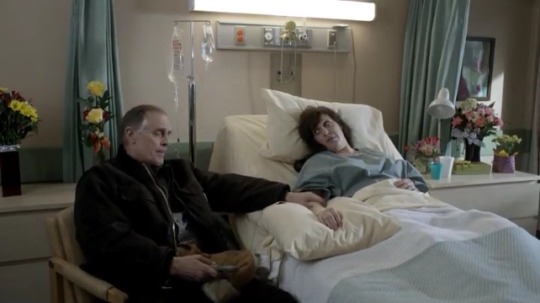
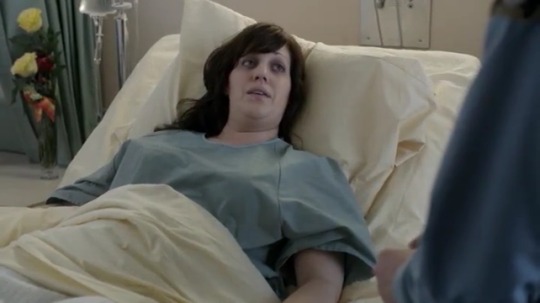
Even in reverse shots of her, the frame contains color and warm tones. Contrast this with a similar OTS shot of Wrench in his hospital room. The temperature of the scene is a lot colder and the frame surrounding him is empty, which is excellent shorthand to communicate loneliness and alienation.
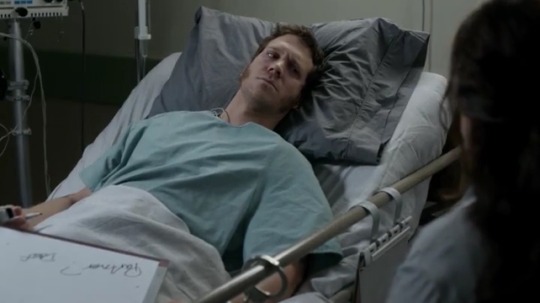
His room also has some kind of mesh over the window, the practical purpose of which (if there is one) eludes me. As I mentioned earlier, hospital windows don’t open, something the writers are obviously aware of, and I’ve personally never been in a hospital room that had a grate or bars over the windows. Regardless of its practical purpose, this is another detail that contributes to the theme of isolation that is present in the design of these scenes. Being in the hospital can be a lonely, alienating experience, which is something I feel is communicated really well here.
These are subtle decisions that make a huge impact on the mood of the scene. I’m gonna be real with you right now, Mr. Wrench is my favorite character and this scene breaks my heart every time I see it. A good deal of that is owed to the quality of the show’s writing and the amazing talent of Russell Harvard and Allison Tolman, but it is always fun to see how my emotions are being relentlessly manipulated by the cinematographer as well. Good job, you guys.
I want to conclude with a proposed alternative to the staging of that last scene.
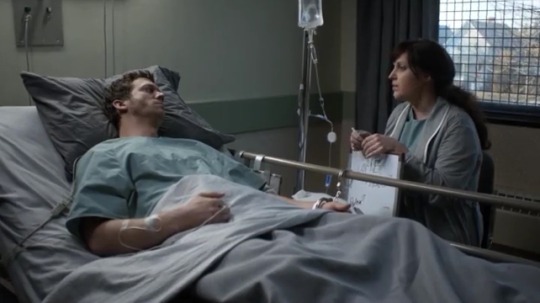
As you can see here, this scene is set during the day, with daylight clearly visible from the window. However, imagine how the emotional intensity might be different if the scene was set at night.
In my experience, nighttime in the hospital can be the most difficult, emotionally speaking, and it’s something I’ve even come to dread as a patient. For the most part, visitors have to go home, the room is dark but the lights are on in the hall and the nurses’ station. You can’t sleep because you’re uncomfortable and people keep coming in to take vitals and blood, and overall it’s very lonely.
So, imagine this scene exactly as it is played out in Season 1, but now instead of a closed off room with daylight coming through the window, the lights in the room are dimmed, it’s night outside (maybe street lights are visible through the window, but not too much). There is a soft glow coming from the heart monitor. Molly is sitting beside the bed with her back to the open door rather than the window. In the background the lights are on in the hall, you can see hospital staff going about their routine in the background. His life is falling apart in this scene, but it’s business as usual for everyone else. Even Molly, as sympathetic as she is, is just doing her job here.
I’m not saying that this staging would have been better, but it would have had a different emotional intensity. I like to see how the environment of the hospital could be used to enhance the mood of a scene, rather than simply act as a back drop because hospitals are deeply personal places, but can be so alienating at the same time. That said, I think that the way they used the environment to impart that sense of loneliness was excellent, and I support the decision to omit certain specifics that might compromise the mood or the flow of the plot.
Oh, and, if you still haven’t done it: go watch Fargo FX.
54 notes
·
View notes